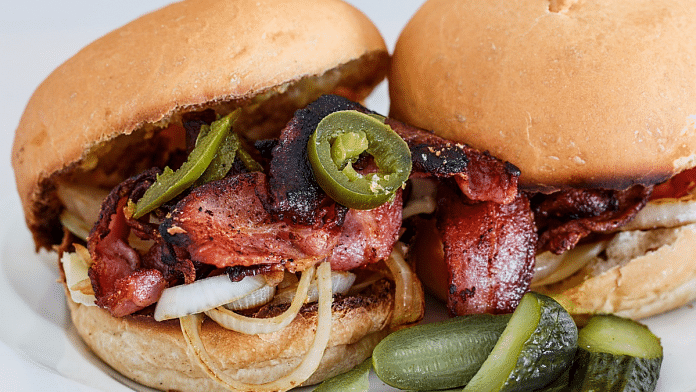One evening, at home. You’re sat comfortably on the sofa, watching your favourite TV show. An ad comes up, showing a scrumptious burger in its full glory. The camera zooms into each ingredient: the crisp salad; the tender meat; the rich, creamy sauce; the crunchy French fries, and one person enjoying this delightful flavour range. You think to yourself that your diet is about to take a hit. But we beg to differ.
In a series of studies published in the Journal of Public Policy & Marketing, we found advertisements showing people eating junk food prompted people on a diet to eat less. While this may seem counterintuitive, these findings are in line with previous research on mental imagery. Recent studies show merely imagining ourselves carrying out actions or experiencing emotions activates similar neural networks to those linked with their actual performance or experience.
What happens when we imagine ourselves eating?
The images we are exposed to throughout our lives hold the power to shape our experiences to a remarkable degree. According to neuroimage studies, the mere sight of someone being hit by a hammer will fire up the neural networks in our brain that are associated with pain. As a result, these images will trigger emotions and behaviour consistent with feelings of pain.
Such effects also extend to food consumption. The field of consumption imagery refers to rich images of food consumption – for example, an ad showing the close-up of a pizza and someone eating it. Some studies have even indicated consumption imagery could cause people to wrongly recall having eaten the food on display.
Why is this important? This is important because simply thinking that we have eaten something can make us feel full. In 2010, researchers asked people to picture themselves eating either 3 or 30 M&M’s chocolates. They then handed them a bowl of sweets to eat. People who had imagined themselves eating 30 of the button-shaped chocolates ended up feeling satiated and ate fewer sweets compared to those who imagined eating only 3. With our research, we decided to take this question to the next level and test if the effect holds when people see someone else eating in an ad.
If you are dieting, seeing someone eating makes you eat less
We invited 132 dieting students at our lab at the Grenoble Ecole de Management to watch an ad. Half of them saw an M&M’s advertisement brimming with consumption imagery: sweets, colours, and a person eating them. The other half of the students saw an ad with two animated M&M’s at a supermarket till, devoid of consumption imagery. We then gave each student a 70g cup of M&M’s and asked them to eat to their heart’s content. Among the students, those who saw the M&M’s advertisement containing consumption imagery ate fewer sweets than those who saw the ad without.
We followed up this study with another one where 130 students saw an advertisement for a hamburger. Out of the volunteer pool, half were asked to visualise themselves eating the hamburger, and the other half were asked to imagine filming it. Students then received a silver bag of chocolate-coated biscuits sticks to eat. Those who watched the ad and imagined eating the hamburger ate fewer chocolate-coated biscuits than those who only imagined filming it.
Both studies are proof that the mere sight of someone eating junk food or of junk food alone is enough to put dieters off it, at least for a time.
How can dieting campaigns help you eat less?
In the next study, we tested whether we could use these findings to promote healthy eating. We predicted that healthy eating promotion campaigns heavy on unhealthy consumption imagery would have a stronger effect on dieters. We designed four ads to incentivise healthy eating:
In total, 594 American adults were recruited to participate in our online study. Each participant was randomly selected to view one of the four ads. We then asked them to imagine that you are about to have a snack and you open a bag of chips. There are 20 chips in the bag. How many potato chips would you eat RIGHT NOW?”
People who viewed the campaign requiring them to imagine themselves wolfing down the French fries indicated a desire to eat fewer chips than those who were exposed to the French fries campaign without consumption imagery. Those who had imagined themselves eating an apple were more inclined to succumb to the potato chips than those who had visualised themselves eating the French fries.
Also read: Study finds how high-fat diet has dramatic consequences on metabolism



